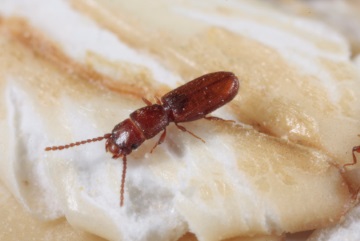The other name of the flat green beetle is Cryptolestes pusillus. The classification order of this beetle is Coleoptera. Laemophloeidae is the family of this insect. The reddish-brown adults of the flat green beetle are small in size ranging from 1.5 to 2.0 mm. It has long antennae which are bead-like in shape.
On the head of the beetle, there is a ridge that is a bit prominent when closely seen. Furthermore, the legs of the larvae are well developed and the body is flat in shape. Larvae have a pale color with a head capsule that is dark in color. Some species resemble the flat green beetle. It includes rusty grain beetles, flour grain beetles, and foreign grain beetles.
The grains, probably the wheat, are commonly infected by the flat green beetle. Other commodities include beans, corn, malt, soybeans, and barley. The damage caused by flat green beetles is not easily identified. To know more about this unique species of beetles, don’t flip the page and keep reading!
Flat Green Beetle Life Cycle
There are four stages in the life cycle of flat green beetles. These reproduction stages are as follows:
- Egg
- Larval
- Pupal
- Adult
The life cycle for all the species of the beetles is the same. They lay eggs in isolation or batches. It depends on the type of beetle. In some cases, they may also lay eggs around the food supply which they have gathered. No one can see the eggs of a flat green beetle with a naked eye.
The number of eggs laid each year is between 40 to 300. It again depends on the type of female species of flat green beetle. In 3 to 10 days, the larvae are developed. The main factors important for the growth of the larvae are temperature and humidity. The larvae will transform into full adults within two to three months.
The average lifespan of flat green beetles is around 6 to 10 months. Although many insects have a lifespan of 3 years, this is not the case with the adult flat green beetle.
Flat Green Beetle Size
The length of the flat green beetle ranges from 1mm to 2mm. The color of the flat green beetle is dark red or brown. They have a flat appearance. Most of the species are found in Canada and Australia. They have specific projections on their head, which make them identifiable. These projections resemble the saw blades.
Large eyes are another feature of flat green beetles. The prominent eyes will make the shape of the head more pointy and visible. Mostly flat green beetles hide in the cracks of the walls or crevices.
Flat green beetles crawl near the stored products. If they are seen, it is best to manage them on the spot rather than infest the whole batch of the products.
Flat Green Beetle Damage
The small size of the flat green beetle is microscopic, so it cannot be easily detected. The infestation or the damage caused by the beetles is not easily identifiable at first. The best way to see if the product is infested is to check the temperature of the product that is suspected to be damaged.
The grain will overheat if the damage is severe. It is recommended to check the same batch and conduct the test and record the temperature. This can help to save other product batches. Sometimes, it can be seen that the beetles are crawling near the product, so it’s better to get rid of it as soon as possible.
Flat Green Beetle Management
The infestation of the flat green beetles can be prevented by cleaning the surfaces regularly and following the basic cleaning protocols. The floors and racks where the products are stored must be sterilized stringently. Another best way is to purchase in small quantities, especially dry food products like grain and wheat.
Rotation of stock can also prevent the destruction of your food products. This means you need to finish the old products first then open the new ones. Airtight containers have proved to be a life savior. You can also store the food items in the fridge or even freeze them.
Glass and metal jars are better to store the products as they are good in quality. The corners of the food storage areas should be squeaky clean. The vacuum cleaner can be used to clean thoroughly.



